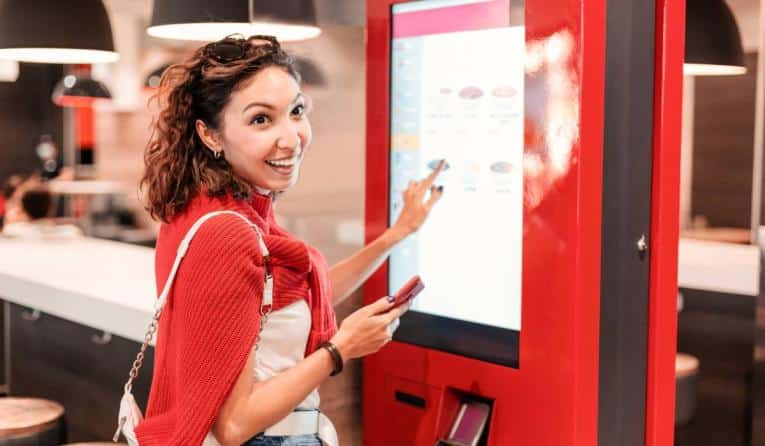As a whole, self-service kiosks—including ATMs, vending machines and in-store and restaurant self-ordering kiosks—are booming across the globe. By 2027, the self-service market is expected to reach a whopping $63 billion, up from $40 billion in 2022. Regarding self-ordering kiosks in restaurants specifically, their popularity has skyrocketed exponentially since the COVID-19 pandemic, and by 2024, it’s estimated that this market will reach approximately $30.8 billion.
Such widespread kiosk adoption on the part of quick-service restaurants and fast casual restaurants is no surprise, as customers love them. Research indicates that about 65 percent of quick-service customers prefer kiosks over traditional ordering systems. While some quick-service owners and franchisees express fear that asking customers to place their own orders may negatively impact their overall experience, the National Restaurant Association finds that 79 percent of customers believe it makes their experience more convenient. Kiosks enable people to easily scan through a menu, pick their items, and pay—all in a matter of seconds. This truly puts the power in customer’s hands, allowing them to assemble their “dream meal” while avoiding long lines and other inefficiencies.
Obviously, kiosks also offer enormous benefits for quick-service restaurants. When customers have simple, seamless experiences, they’re more likely to come back. Plus, kiosks help restaurants sell more, by suggesting add-on options to meals like a side of fries or a drink. Many self-service restaurant kiosks also include add-ons, such as a barcode scanner for accepting coupons, which also works to increase sales; and of course, pre-set tips are a nice feature as well for servers.
Consequently, research shows that restaurant customers that interact with self-service kiosks typically purchase 10 percent to 30 percent more than those who engage with restaurant employees. Additionally, kiosks can help address the labor shortage that is afflicting quick service and fast casual restaurants across the country. After all, these systems work 24×7.
Other benefits include the ability to better understand customers’ buying behavior, in order to more effectively up-sell and cross-sell items to in-store traffic. Overall, quick-service restaurants are profiting big time from kiosks. For example, in a 2022 earnings call, Shake Shack CFO Katie Fogerty said that kiosks are the chain’s most profitable channel. Meanwhile, Panera experienced an 11.5 percent surge in sales two years after the company implemented tablet kiosk ordering.
In spite of all these benefits, there’s a wrinkle. Kiosks generate an enormous amount of log data, or the records of all the events occurring in a kiosk. This unfortunately can overwhelm existing systems and efforts aimed at keeping kiosks highly performant – up and running, fast and reliable. If this log data is not harnessed and leveraged correctly, the result can be unplanned kiosk downtime which can really hurt a restaurant business. Seeing as 61 percent of customers spend more when placing orders through kiosk solutions, it’s easy to see how extended bouts of kiosk downtime or slowness (which alienates customers) can cut heavily into sales. Restaurants need to prepare now to avert data disasters.
The first step to preventing issues is implementing observability—which is used across industries to keep technology working as intended. Observability refers to the ability to determine how well an app or system is working based on the data it is outputting, and for restaurants, it can be a sound way to track kiosk performance. This strategy enables companies to receive proactive alerts if something is going awry.
But when data piles up, analyzing and deriving meaning from that data gets harder and harder. Soon there’s simply too much of it to wade through in order to figure out what may be going on with a malfunctioning kiosk. When an issue with a kiosk occurs, the first step is often a call to the company’s IT team. From there, that team goes to work manually digging through troves of data to identify the problem. It’s a rigorous, complicated, and lengthy process. In the meantime, customers are getting frustrated, employees are scrambling to keep up with orders and lines are getting longer. If problems at a particular establishment occur frequently enough, customers might abandon the restaurant entirely.
This pace of data growth isn’t going to slow down any time soon. Here’s the solution: every individual store in a quick-service or fast-casual chain needs to start processing and analyzing their own data, the moment it comes into existence. In doing so, the individual restaurant can automatically detect any potential issues or growing hotspots, as they are occurring. If there is a warning or error, the kiosk itself—not a frazzled employee in the middle of lunch duty—can alert the IT department automatically. Then, technical experts can then catch and remediate the issue early, in most cases before kiosk performance begins to degrade.
Kiosks are here to stay, but by and large, the systems and processes designed to monitor their health and performance aren’t prepared to handle the enormous amount of data they are generating. To keep self-service kiosks chugging along—and power in the hands of consumers, and profit-generating potential in the hands of restaurants—businesses need to implement strategies that address data from its very creation.
Ozan Unlu is the CEO and Founder of Edge Delta, an edge observability platform. Previously he served as a Senior Solutions Architect at Sumo Logic; a Software Development Lead and Program Manager at Microsoft; and a Data Engineer at Boeing. Ozan holds a BS in nanotechnology from the University of Washington.









